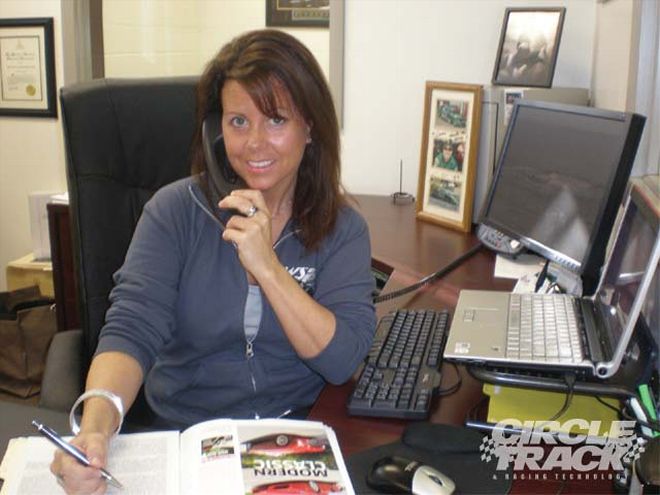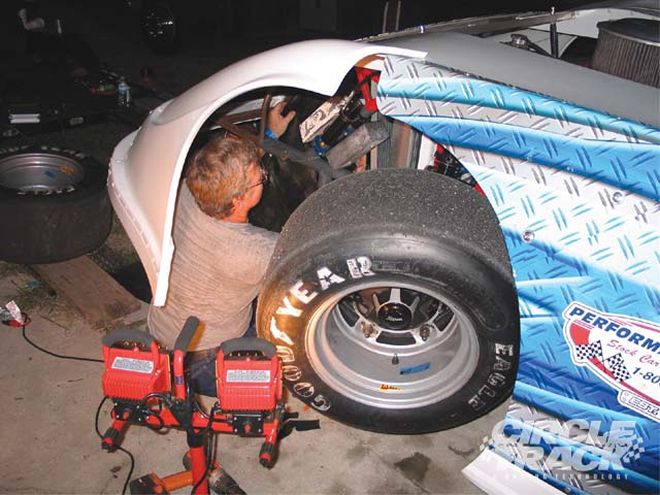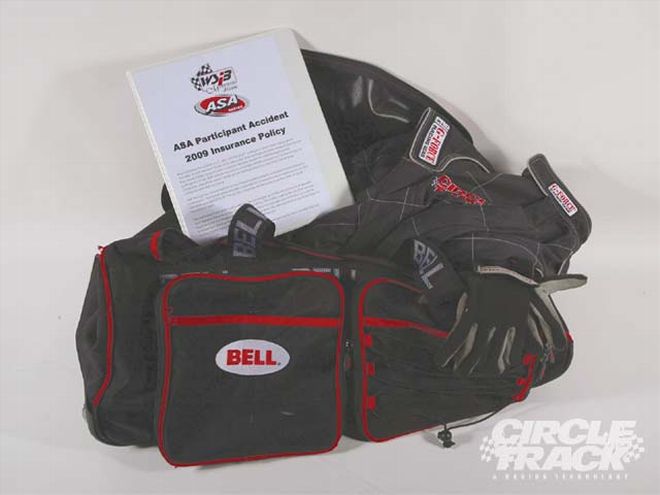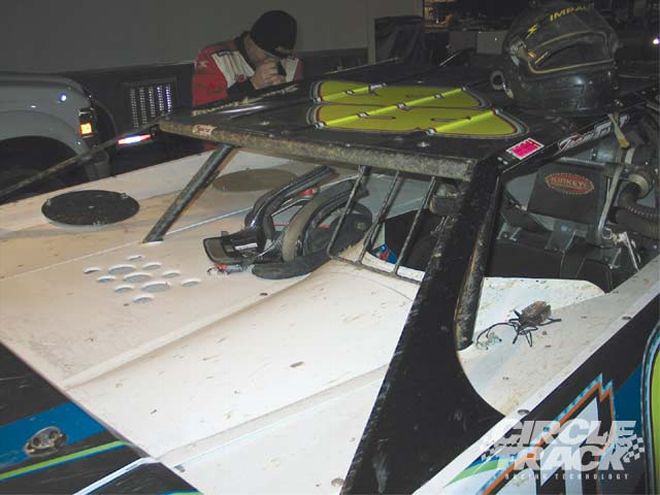
 Close racing like this often leads to problems. Are you properly prepared? </br>Steve Himlestein
Close racing like this often leads to problems. Are you properly prepared? </br>Steve Himlestein
You've done this a thousand times. You climb into the race car and the checklist of safety equipment goes on autopilot:
Helmet: CHECK!
Gloves: CHECK!
Belts: CHECK!
Insurance: CHE...
Wait. What?!
Yes, insurance. And not just for the tow vehicle. Insurance for you.
Racing is fun. In many ways it's an addiction. But you can't let that get in the way of being responsible about how you approach the basics of safety. I'm sure you won't skimp on that next helmet purchase, or your rollcage. And you shouldn't skimp when it comes to the additional level of protection for yourself, and your family.
We all know that auto racing is dangerous and accidents do happen, but by taking a few minutes on the telephone, off the racetrack, can greatly increase your safety (and peace of mind) on it.
Erica Smetters"> Racing is a dangerous sport but safety equipment technology has come along way. Those advancements have made good insurance policies more affordable, even for the short-track racer.</br> Erica Smetters
Racing is a dangerous sport but safety equipment technology has come along way. Those advancements have made good insurance policies more affordable, even for the short-track racer.</br> Erica Smetters
This isn't the time to be macho. You're not invincible, no matter what you think. And as a word of warning, don't get caught in the mode of thinking that any coverage you may currently have is sufficient; many policies have exclusions specifically for motorsports and you may not even know it. Even more importantly, don't think that any coverage offered by your local track is "good enough" because, trust me, there are some promoters in our sport who are not looking out for your best interests once the back gate fees are handed over.
Insurance is one of those things that we all need, but hope we never use. But if you do have a need to activate a policy, you better believe that you'll be glad you got the best one possible. I've been around racing my entire life and have seen the consequences of drivers getting seriously injured without any additional insurance, and the medical bills and emotional stress has ruined their entire family. But had they taken a few minutes to explore their options prior to buckling into the car, it could have been a completely different story.
WSIB Motorsports Insurance"> The key to getting a good insurance policy is to work with a good agent/broker says Laura Hauenstein, President of WSIB Motorsports Insurance.</br> WSIB Motorsports Insurance
The key to getting a good insurance policy is to work with a good agent/broker says Laura Hauenstein, President of WSIB Motorsports Insurance.</br> WSIB Motorsports Insurance
One thing that has kept many racers from adding an insurance policy to their safety gear is the longtime stigma that it's expensive. I suspect that once you begin to do a little research, the options are far more affordable than you might think.
"Historically, the costs have been somewhat prohibitive, but today, motorsports policies can actually be quite affordable as the injury and death rate have fallen dramatically thanks to the advances in safety equipment and technology," explains Laura Hauenstein, President of WSIB Motorsports Insurance. With more than two decades in the motorsports insurance business, Hauenstein offers her advice to those thinking about adding a racing-specific policy.
"The first thing I would say is that it's very important to call a company that specializes in motorsports. You simply can't call your `typical' home, life or car insurance broker as it generally won't know which companies have racing exclusions or understand the varying surcharges. But by working with someone connected to the industry you get to use their expertise and can have a policy tailored specifically to your individual needs and type of racing activity."
Hauenstein explained that a knowledgeable agent will take a lot of things into consideration when formulating a motorsports policy; no two cases are alike and this is not a product, like a pair of driving shoes, which can simply be bought "off the shelf."
Actually, it makes sense when you think it through. A Late Model racer on a dirt track will face drastically different situations in his or her racing career than a drag racer, or the guy turning left and right on a road course. It's understandable how each would require a completely different type of policy.
Rob Fisher"> ASA Racing President Dennis Huth (middle) shares a laugh with East Bay Raceway Park President Al Varnadore (left) and Vice President Todd Hutto high atop the main grandstand at the Tampa, FL area track. As an ASA-sanctioned facility Varnadore is able to offer his racers an insurance policy with a $500,000 Excess Medical Benefit as well as a $20,000 Accidental Death and Dismemberment Benefit.</br> Rob Fisher
ASA Racing President Dennis Huth (middle) shares a laugh with East Bay Raceway Park President Al Varnadore (left) and Vice President Todd Hutto high atop the main grandstand at the Tampa, FL area track. As an ASA-sanctioned facility Varnadore is able to offer his racers an insurance policy with a $500,000 Excess Medical Benefit as well as a $20,000 Accidental Death and Dismemberment Benefit.</br> Rob Fisher
"The rates can and will vary greatly depending on a number of factors," Hauenstein says. "The number of races is one of the primary items taken into consideration. An SCCA sports car racer doing eight or 10 races will pay a much different rate than a NASCAR driver who competes 30 or more times a year. The type of cars, the speed and horsepower of the cars, and even the racetracks themselves are all the type of things that are taken into consideration."
She also offered a yellow caution flag of her own. "Some of the agents familiar with motorsports will use the internet to do a little research on the driver. If they find that they have a history of crashing, for example, the rates will be higher," Hauenstein says.
When thinking about the unique insurance needs for a racer, there really are two different types that should be added to your existing portfolio of coverage--life insurance, and disability. Both cover different scenarios and both should be part of your safety equipment, supplementing any medical, worker's comp, or other insurance you may already have.
Life insurance pays off in the unlikely, but potential, event that you are killed on the racetrack. This will provide financially for your family and their future.
Phil Hubbard"> This 526 inch aluminum alcohol fuel Hemi has a bit more horsepower than what circle track racers are used to--how's 1,400 to 1,700 hp depending on the tune? With all that muscle and a hefty racing schedule, driver/owner Dave Young's insurance requirements are different than a typical hobby stock racer.</br> Phil Hubbard
This 526 inch aluminum alcohol fuel Hemi has a bit more horsepower than what circle track racers are used to--how's 1,400 to 1,700 hp depending on the tune? With all that muscle and a hefty racing schedule, driver/owner Dave Young's insurance requirements are different than a typical hobby stock racer.</br> Phil Hubbard
"When they are just starting out, a lot of the younger drivers think they are invincible and they don't see a need for insurance," Hauenstein says. "They spend their money on toys. But as they get older, get married, and maybe start a family, then is when they see the importance of providing more stability. Often times, it may even be the wife who makes the initial call to us."
Like most insurance you have, there are no set rules for what amount of coverage is needed. Every case is individual, but there are some rules of thumb. Generally, when it comes to life insurance, look for a policy that will pay three to fives times your annual earnings if possible. Take into account any major items that might need paying off as well, such as a mortgage. Life insurance doesn't only need to cover your current earnings, but it should protect the family and take care of their future needs as well. An example of this would be taking into consideration future college tuition expenses for any children in the household.
Rob Fisher"> You can even get a policy that covers your crew while it's at the track working on the car.</br> Rob Fisher
You can even get a policy that covers your crew while it's at the track working on the car.</br> Rob Fisher
"Typically, a young driver with a huge career ahead of him can get more than someone closer to the end of his career. What we are doing is insuring against future earnings, and everyone is worth something," Hauenstein says. What this means, is that a driver like Joey Logano, who, at 18 years of age and stepping into one of the top rides in the NASCAR Sprint Cup Series, is much more likely to qualify for a higher life or disability insurance policy than your average weekend warrior running a stock class.
On the other hand, disability insurance covers a situation where you're injured and can't race anymore. The money from the policy pays what you might have earned on the racetrack or at that regular 9-5 job while you recover and, if needed, are trained in a new profession. Again, every individual's situation and needs are different, but generally Hauenstein says that you should try to obtain a policy that pays between 67 and 72 percent of your weekly income. If you happen to be permanently injured and unable to return to work, the three to five times your annual income rule of thumb is a good place to start looking in regards to a permanent payout.
"Disability insurance will help to cover your bills and get you back up and running again," she says. "But in this case there are other things that can come into play and influence the policy fees greatly. Like with your car insurance, there is a deductible that can be higher or lower depending on your preference.
Patrick Hill"> No weekend racing bag is complete without a good insurance policy.</br> Patrick Hill
No weekend racing bag is complete without a good insurance policy.</br> Patrick Hill
"For example, if a driver was to have enough cash in the bank to help him survive fiscally for three to six months before the policy kicked in, his coverage would be much cheaper. This is why no two drivers will pay the same amount for a policy. There are simply too many variables."
There are a lot of companies today offering motorsports insurance. Simply typing "motorsports insurance" into Google results in more than 2.5 million results, many of which are brokers offering policies.
Don't get fooled into thinking that the coverage by the sanctioning body you race with, or the racetrack at which you compete, offer adequate insurance. They don't, and the coverage provided varies greatly.
Just as one example, American Speed Association members in good standing will be eligible for a $500,000 Excess Medical Benefit as well as a $20,000 Accidental Death and Dismemberment Benefit. Uniquely, this coverage begins while traveling to a location promoting an ASA-sanctioned event and continues until arrival home again (assuming the basic guidelines are followed and no exclusions, such as drinking and driving, are violated). So, essentially you are covered from the time you leave the driveway at the shop until returning back again, something no other sanction in the industry is able to offer.
While ASA offers perhaps the best member insurance in the industry, on the other hand, some of the smaller racetracks may only offer a policy that pays somewhere between $5,000 to $25,000, barely enough to cover any hospital needs. The burden falls squarely on you, the racers, to learn exactly what your track or sanction provides and supplement that insurance accordingly. Before you ever put your car on the track, you should be aware of what type of insurance is offered, and get a copy in writing.
Rob fisher"> Here's something you don't see too often, a HANS sitting on a Dirt Late Model deck. "I've got a family to think about," says driver Shon Flannary. Because he wears an H-n-R, he can get a discount on a motorsports insurance policy.</br> Rob fisher
Here's something you don't see too often, a HANS sitting on a Dirt Late Model deck. "I've got a family to think about," says driver Shon Flannary. Because he wears an H-n-R, he can get a discount on a motorsports insurance policy.</br> Rob fisher
Obviously, some sanctions and tracks offer better protection than others, and if you only take one thing away from this story it should be this: The one person responsible for taking care of you and your family is YOU. You need to protect yourself beyond what any participant accident policy is available through the sanction or track.
Take the tragic case of Paul Dana, the IndyCar Series driver who died in a practice accident at Homestead Miami Speedway in 2006. Unlike many racers, Dana had taken the initiative himself and got a motorsports insurance policy before that tragic day in March.
"Paul and I had both been around the sport for a long time before Paul made it to IndyCars, and he had known guys who died in their cars," says Greg Dana, Paul's brother. "We all hope and pray it won't happen to us, but reality is that you never know who will be next. Paul's family is fortunate that he took the steps necessary to protect them."
While the scope of this article is not to recommend any specific companies for your motorsports insurance needs, one thing to keep in mind is that like a visit to the doctor's office, you can and should ask for a second opinion.
"Your agent will try to get as much as possible for you based on your individual situation, form of racing, and all the other variables we've discussed," Hauenstein says. "That's why you need to work with a reputable broker who is familiar with racing and the unique attributes of the sport. But it's OK to try someone else for another opinion. You should shop around when first starting to look for coverage."
And though safety has increased exponentially over the past few years, accidents do happen. Just by taking the right precautions and obtaining the necessary motorsports-specific insurance can eliminate many problems that could plague you for the rest of your life.
So go ahead, throw a policy in the bag with your helmet and driving suit.